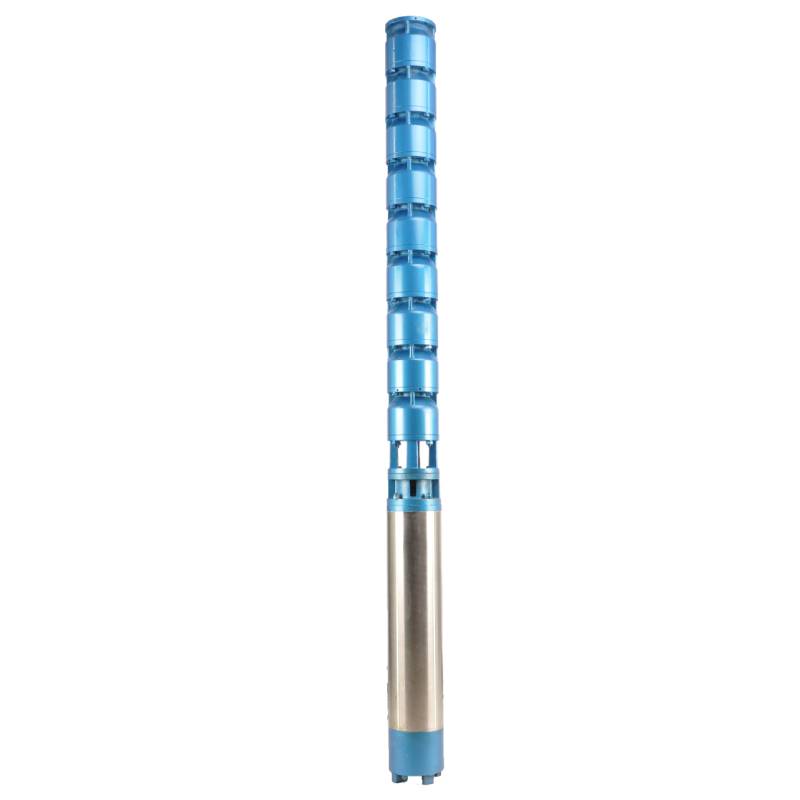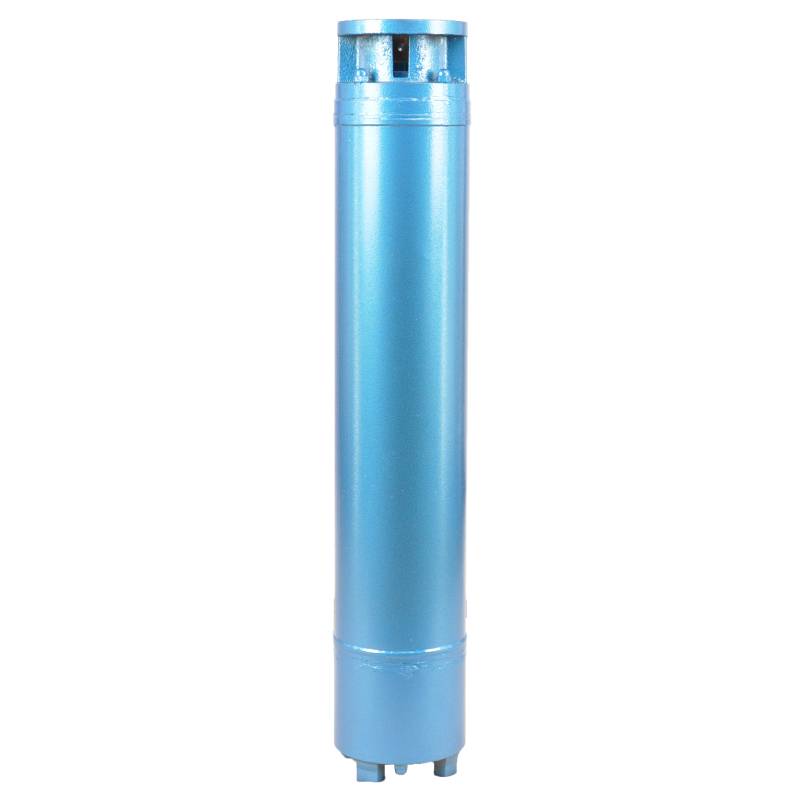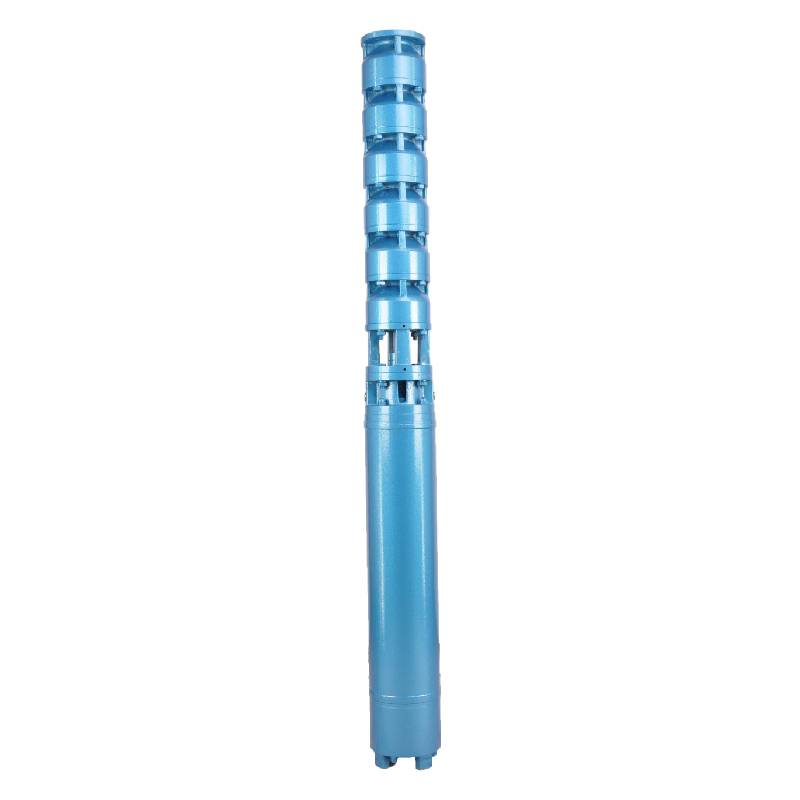The motor winding adopts special water-resistant wire for frequency conversion winding, which has excellent characteristics such as high frequency stamping resistance, pulse peak voltage stamping resistance and high temperature aging resistance. The frequency conversion winding design ensures the long-term stable conversion operation of the motor between 1HZ-50HZ, making the frequency conversion deep well pump more energy saving and longer service life.
The product is supplied by three-phase AC 380V (tolerance ± 5%), 50HZ (tolerance ± 1%). Applicable water quality conditions include water temperature not exceeding 20 °C, solid impurities content (mass ratio) is not greater than 0.01%, PH value (pH) is 6.5-8.5, hydrogen sulfide content is not more than 1.5mg/L, chloride ion content is not more than 400mg/L. The motor adopts closed or water-filled wet structure. Before use, the internal chamber needs to be filled with clean water to prevent virtual filling. The pump needs to be completely immersed in water, the penetration depth shall not exceed 70m, and the distance from the bottom of the well shall not be less than 3m. The water inlet of the well shall meet the water output and continuous operation requirements of the pump, and the output of the pump shall be controlled at 0.7-1.2 times of the rated flow. The pump shall be used vertically, and the pump must be matched with the cable according to the requirements and equipped with external overload protection device. It is strictly prohibited to conduct no-load test of the pump, and it is necessary to avoid operation without water.
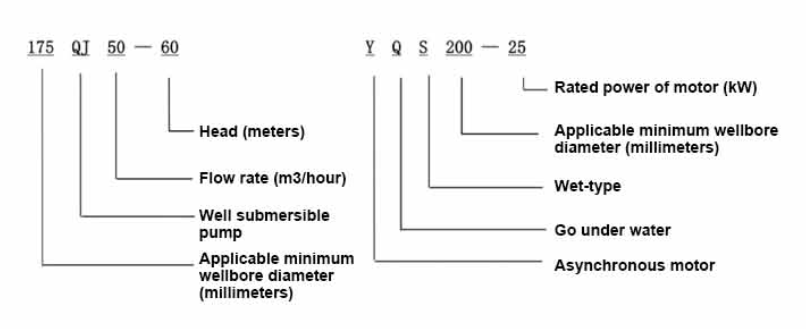
| Modell | Durchfluss (m3/h) | Kopf (M) |
Rotatingspeed(change/point) | Wasserpumpe(%) | Auslauf Durchmesser (mm) |
Gut anwendbar Durchmesser (mm) |
Bewertet Leistung (KW) |
Bewertet Spannung (V) |
Bewertet Strom (A) |
Motoreffizienz (%) | power factorcosφ | Einheit Radiale Maximalgröße (mm) |
Anmerkung | |||||||||
| 150QJ5-100 | 5 | 100 | 2850 | 58 | 40 | 150 | 3 | 380 | 7.9 | 74.0 | 0.78 | 143 | ||||||||||
| 150QJ5-150 | 5 | 150 | 2850 | 58 | 40 | 150oben | 4 | 380 | 10.25 | 75.0 | 0.79 | 143 | ||||||||||
| 150QJ5-200 | 200 | 5.5 | 13.74 | 76.0 | 0.8 | |||||||||||||||||
| 150QJ5-250 | 250 | 7.5 | 18.5 | 77.0 | 0.8 | |||||||||||||||||
| 150QJ5-300 | 300 | 9.2 | 22.12 | 78.0 | 0.81 | |||||||||||||||||
| 150QJ10-50 | 10 | 50 | 2850 | 63 | 50 | 150über | 3 | 380 | 7.9 | 74.0 | 0.78 | 143 | ||||||||||
| 150QJ10-66 | 66 | 4 | 10.25 | 75.0 | 0.79 | |||||||||||||||||
| 150QJ10-78 | 78 | 4 | 10.25 | 75.0 | 0.79 | |||||||||||||||||
| 150QJ10-84 | 84 | 5.5 | 13.74 | 76.0 | 0.8 | |||||||||||||||||
| 150QJ10-91 | 91 | 5.5 | 13.74 | 76.0 | 0.8 | |||||||||||||||||
| 150QJ10-100 | 100 | 5.5 | 13.74 | 76.0 | 0.8 | |||||||||||||||||
| 150QJ10-128 | 128 | 7.5 | 18.5 | 77.0 | 0.8 | |||||||||||||||||
| 150QJ10-150 | 150 | 7.5 | 18.5 | 77.0 | 0.8 | |||||||||||||||||
| 150QJ10-200 | 200 | 11 | 26.28 | 78.5 | 0.81 | |||||||||||||||||
| 150QJ10-250 | 250 | 13 | 30.87 | 79.0 | 0.81 | |||||||||||||||||
| 150QJ10-300 | 300 | 15 | 35.62 | 79.0 | 0.81 | |||||||||||||||||
| 150QJ15-33 | 15 | 33 | 2850 | 63 | 50 | 150über | 3 | 380 | 7.9 | 74.0 | 0.78 | 143 | ||||||||||
| 150QJ15-42 | 42 | 4 | 10.25 | 75.0 | 0.79 | |||||||||||||||||
| 150QJ15-50 | 50 | 4 | 10.25 | 75.0 | 0.79 | |||||||||||||||||
| 150QJ15-60 | 60 | 5.5 | 13.74 | 76 | 0.8 | |||||||||||||||||
| 150QJ15-65 | 65 | 5.5 | 13.74 | 76.0 | 0.8 | |||||||||||||||||
| 150QJ15-72 | 72 | 5.5 | 13.74 | 76.0 | 0.8 | |||||||||||||||||
| 150QJ15-81 | 81 | 7.5 | 18.5 | 77.0 | 0.8 | |||||||||||||||||
| 150QJ15-90 | 90 | 7.5 | 18.5 | 77.0 | 0.8 | |||||||||||||||||
| 150QJ15-98 | 98 | 7.5 | 18.5 | 77.0 | 0.8 | |||||||||||||||||
| 150QJ15-106 | 106 | 9.2 | 22.12 | 78.0 | 0.81 | |||||||||||||||||
| 150QJ15-114 | 114 | 9.2 | 22.12 | 78.0 | 0.81 | |||||||||||||||||
| 150QJ15-130 | 130 | 11 | 26.28 | 78.5 | 0.81 | |||||||||||||||||
| 150QJ15-146 | 146 | 13 | 30.87 | 79.0 | 0.81 | |||||||||||||||||
| 150QJ15-162 | 162 | 13 | 30.87 | 79.0 | 0.81 | |||||||||||||||||
| 150QJ15-180 | 180 | 15 | 35.62 | 79.0 | 0.81 | |||||||||||||||||
| 150QJ20-26 | 20 | 26 | 2850 | 64 | 50 | 150über | 3 | 380 | 7.9 | 74.0 | 0.78 | 143 | ||||||||||
| 150QJ20-33 | 33 | 3 | 7.9 | 74.0 | 0.78 | |||||||||||||||||
| 150QJ20-39 | 20 | 39 | 2850 | 64 | 50 | 150über | 4 | 380 | 10.25 | 75.0 | 0.79 | 143 | ||||||||||
| 150QJ20-52 | 52 | 5.5 | 13.74 | 76.0 | 0.8 | |||||||||||||||||
| 150QJ20-65 | 65 | 7.5 | 18.5 | 77.0 | 0.8 | |||||||||||||||||
| 150QJ20-78 | 78 | 7.5 | 18.5 | 77.0 | 0.8 | |||||||||||||||||
| 150QJ20-91 | 91 | 9.2 | 22.12 | 78.0 | 0.81 | |||||||||||||||||
| 150QJ20-98 | 98 | 9.2 | 22.12 | 78.0 | 0.81 | |||||||||||||||||
| 150QJ20-104 | 104 | 11 | 26.28 | 78.5 | 0.81 | |||||||||||||||||
| 150QJ20-111 | 111 | 11 | 26.28 | 78.5 | 0.81 | |||||||||||||||||
| 150QJ20-130 | 130 | 13 | 30.87 | 79.0 | 0.81 | |||||||||||||||||
| 150QJ20-143 | 143 | 13 | 30.87 | 79.0 | 0.81 | |||||||||||||||||
| 150QJ20-156 | 156 | 15 | 35.62 | 79.0 | 0.81 | |||||||||||||||||
| 150QJ20-182 | 182 | 18.5 | 43.12 | 79.5 | 0.82 | |||||||||||||||||
| 150QJ25-24 | 25 | 24 | 2850 | 64 | 65 | 150über | 3 | 380 | 7.9 | 74.0 | 0.78 | 143 | ||||||||||
| 150QJ25-32 | 32 | 4 | 10.25 | 75.0 | 0.79 | |||||||||||||||||
| 150QJ25-40 | 40 | 5.5 | 13.74 | 76.0 | 0.8 | |||||||||||||||||
| 150QJ25-48 | 48 | 5.5 | 13.74 | 76.0 | 0.8 | |||||||||||||||||
| 150QJ25-56 | 56 | 7.5 | 18.5 | 77.0 | 0.8 | |||||||||||||||||
| 150QJ25-64 | 64 | 7.5 | 18.5 | 77.0 | 0.8 | |||||||||||||||||
| 150QJ25-72 | 72 | 9.2 | 22.12 | 78.0 | 0.81 | |||||||||||||||||
| 150QJ25-77 | 77 | 9.2 | 22.12 | 78.0 | 0.81 | |||||||||||||||||
| 150QJ25-84 | 84 | 11 | 26.28 | 78.5 | 0.81 | |||||||||||||||||
| 150QJ25-96 | 96 | 11 | 26.28 | 78.5 | 0.81 | |||||||||||||||||
| 150QJ25-104 | 104 | 13 | 30.87 | 79.0 | 0.81 | |||||||||||||||||
| 150QJ25-110 | 110 | 13 | 30.87 | 79.0 | 0.81 | |||||||||||||||||
| 150QJ25-120 | 120 | 15 | 35.62 | 79.0 | 0.81 | |||||||||||||||||
| 150QJ25-128 | 128 | 15 | 35.62 | 79.0 | 0.81 | |||||||||||||||||
| 150QJ25-136 | 136 | 18.5 | 43.12 | 79.5 | 0.82 | |||||||||||||||||
| 150QJ25-154 | 154 | 18.5 | 43.12 | 79.5 | 0.82 | |||||||||||||||||
| 150QJ32-18 | 32 | 18 | 2850 | 66 | 80 | 150über | 3 | 380 | 7.9 | 74.0 | 0.78 | 143 | ||||||||||
| 150QJ32-24 | 24 | 4 | 10.25 | 75.0 | 0.79 | |||||||||||||||||
| 150QJ32-30 | 30 | 5.5 | 13.74 | 76.0 | 0.8 | |||||||||||||||||
| 150QJ32-36 | 36 | 5.5 | 13.74 | 76.0 | 0.8 | |||||||||||||||||
| 150QJ32-42 | 32 | 42 | 2850 | 66 | 80 | 150über | 7.5 | 380 | 18.5 | 77.0 | 0.8 | 143 | ||||||||||
| 150QJ32-54 | 54 | 9.2 | 22.12 | 78.0 | 0.81 | |||||||||||||||||
| 150QJ32-66 | 66 | 11 | 26.28 | 78.5 | 0.81 | |||||||||||||||||
| 150QJ32-72 | 72 | 13 | 30.87 | 79.0 | 0.81 | |||||||||||||||||
| 150QJ32-84 | 84 | 13 | 30.87 | 79.0 | 0.81 | |||||||||||||||||
| 150QJ32-90 | 90 | 15 | 35.62 | 79.0 | 0.81 | |||||||||||||||||
| 150QJ32-96 | 96 | 15 | 35.62 | 79.0 | 0.81 | |||||||||||||||||
| 150QJ32-114 | 114 | 18.5 | 43.12 | 79.5 | 0.82 | |||||||||||||||||
| 150QJ40-16 | 40 | 16 | 2850 | 66 | 80 | 150über | 3 | 380 | 7.9 | 74.0 | 0.78 | 143 | ||||||||||
| 150QJ40-24 | 24 | 5.5 | 13.74 | 76.0 | 0.8 | |||||||||||||||||
| 150QJ40-30 | 30 | 5.5 | 13.74 | 76.0 | 0.8 | |||||||||||||||||
| 150QJ40-40 | 40 | 7.5 | 18.5 | 77.0 | 0.8 | |||||||||||||||||
| 150QJ40-48 | 48 | 9.2 | 22.12 | 78.0 | 0.81 | |||||||||||||||||
| 150QJ40-56 | 56 | 11 | 26.28 | 78.5 | 0.81 | |||||||||||||||||
| 150QJ40-64 | 64 | 13 | 30.87 | 79.0 | 0.81 | |||||||||||||||||
| 150QJ40-72 | 72 | 13 | 30.87 | 79.0 | 0.81 | |||||||||||||||||
| 150QJ40-80 | 80 | 15 | 35.62 | 79.0 | 0.81 | |||||||||||||||||
| 150QJ40-96 | 96 | 18.5 | 43.12 | 79.5 | 0.82 | |||||||||||||||||
| 150QJ50-16 | 50 | 16 | 2850 | 65 | 80 | 150über | 4 | 380 | 10.25 | 75.0 | 0.79 | 143 | ||||||||||
| 150QJ50-22 | 22 | 5.5 | 13.74 | 76.0 | 0.8 | |||||||||||||||||
| 150QJ50-28 | 28 | 7.5 | 18.5 | 77.0 | 0.8 | |||||||||||||||||
| 150QJ50-34 | 34 | 9.2 | 22.12 | 78.0 | 0.81 | |||||||||||||||||
| 150QJ50-40 | 40 | 9.2 | 22.12 | 78.0 | 0.81 | |||||||||||||||||
| 150QJ50-46 | 46 | 11 | 26.28 | 78.5 | 0.81 | |||||||||||||||||
| 150QJ50-52 | 52 | 13 | 30.87 | 79.0 | 0.81 | |||||||||||||||||
| 150QJ50-57 | 57 | 15 | 35.62 | 79.0 | 0.81 | |||||||||||||||||
| 150QJ50-74 | 74 | 18.5 | 43.12 | 79.5 | 0.82 | |||||||||||||||||
| 150QJ50-80 | 80 | 18.5 | 43.12 | 79.5 | 0.82 | |||||||||||||||||
| 150QJ63-12 | 63 | 12 | 2850 | 60 | 80 | 150über | 4 | 380 | 10.25 | 75.0 | 0.79 | 143 | ||||||||||
| 150QJ63-18 | 18 | 7.5 | 18.5 | 77.0 | 0.8 | |||||||||||||||||
| 150QJ63-30 | 30 | 9.2 | 22.12 | 78.0 | 0.81 | |||||||||||||||||
| 150QJ63-36 | 36 | 11 | 26.28 | 78.5 | 0.81 | |||||||||||||||||
| 150QJ63-42 | 63 | 42 | 2850 | 60 | 80 | 150über | 13 | 380 | 30.87 | 79.0 | 0.81 | 143 | ||||||||||
| 150QJ63-48 | 48 | 15 | 35.62 | 79.0 | 0.81 | |||||||||||||||||
| 150QJ63-54 | 54 | 18.5 | 43.12 | 79.5 | 0.82 | |||||||||||||||||
| 150QJ15-220 | 15 | 220 | 2850 | 50 | 150über | 18.5 | 380 | 43.12 | 143 | |||||||||||||
| 150QJ15-260 | 260 | 20 | 49.7 | |||||||||||||||||||
| 150QJ15-300 | 300 | 25 | 56.5 | |||||||||||||||||||
| 150QJ20-210 | 20 | 210 | 2850 | 50 | 150über | 20 | 380 | 49.7 | 143 | |||||||||||||
| 150QJ20-240 | 240 | 25 | 56.5 | |||||||||||||||||||
| 150QJ20-290 | 290 | 30 | 66.6 | |||||||||||||||||||
| 150QJ25-175 | 25 | 175 | 2850 | 65 | 150über | 20 | 49.7 | 143 | ||||||||||||||
| 150QJ25-200 | 200 | 30 | 66.6 | |||||||||||||||||||
| 150QJ25-290 | 290 | 37 | 82.1 | |||||||||||||||||||
| 150QJ32-120 | 32 | 120 | 2850 | 80 | 150über | 20 | 380 | 49.7 | 143 | |||||||||||||
| 150QJ32-132 | 132 | 25 | 56.5 | |||||||||||||||||||
| 150QJ32-156 | 156 | 30 | 66.6 | |||||||||||||||||||
| 150QJ32-190 | 190 | 37 | 82.1 | |||||||||||||||||||
| 150QJ32-240 | 240 | 45 | 96.9 | |||||||||||||||||||
| 150QJ40-110 | 40 | 110 | 2850 | 80 | 150über | 20 | 380 | 49.7 | 143 | |||||||||||||
| 150QJ40-121 | 121 | 25 | 56.5 | |||||||||||||||||||
| 150QJ40-143 | 143 | 30 | 66.6 | |||||||||||||||||||
| 150QJ40-176 | 176 | 37 | 82.1 | |||||||||||||||||||
| 150QJ40-220 | 220 | 45 | 96.9 | |||||||||||||||||||
| 150QJ50-100 | 50 | 100 | 2850 | 80 | 150über | 20 | 380 | 49.7 | 143 | |||||||||||||
| 150QJ50-110 | 110 | 25 | 56.5 | |||||||||||||||||||
| 150QJ50-130 | 130 | 30 | 66.6 | |||||||||||||||||||
| 150QJ50-160 | 160 | 37 | 82.1 | |||||||||||||||||||
| 150QJ50-200 | 200 | 45 | 96.9 | |||||||||||||||||||
This well submersible pump is a pump suitable for clean water. It is strictly prohibited to pump sediment and turbid water in new wells. The voltage level of the pump is 380/50HZ. Other voltage levels of the submersible motor need to be customized. Underground cables must be waterproof and must be equipped with starting equipment, such as distribution box, etc. The starting equipment should have common motor comprehensive protection functions, such as short circuit overload protection, phase loss protection, undervoltage protection, grounding protection and idling protection, etc. Under abnormal circumstances, the protection device should be tripped in time. In the process of installation and use, the pump must be reliably grounded. It is prohibited to push and pull the switch when the hands and feet are wet. The power must be cut off before installation and maintenance of the pump. The place where the pump is used must set up a clear "anti-electric shock" mark. Before going down the well or installation, the motor must be filled with distilled water or non-corrosive cool water, and the water inlet and outlet screws must be tightened. When testing the pump, water must be injected into the pump chamber to lubricate the rubber bearings. The instant start shall not exceed one second to check whether the direction is correct. It is necessary to pay attention to the safety of the pump when it is erected to prevent it from toppling and hurting people. Strictly in accordance with the provisions of the pump lift and flow range of use, so as not to have a large flow in the low lift pump or a large pull in the high lift, causing extreme wear of thrust bearings and other components, resulting in motor overload burn. After the pump into the well, the measurement of the motor and ground insulation resistance, not less than 100M. After the start, regular observation of voltage and current, and check whether the motor winding insulation meets the requirements; if the pump storage location temperature is below freezing, storage should discharge the water in the motor cavity, to prevent the water in the motor cavity due to low temperature and freeze damage the motor.
Kurze Einführung in die Struktur: Der Pumpenteil besteht hauptsächlich aus Pumpenwelle, Laufrad, Umleitungsgehäuse, Gummilager, Rückschlagventilkörper (optionale Teile) und anderen Komponenten. Der Motorteil besteht hauptsächlich aus Basis, Druckregulierungsfolie, Axiallager, Axialplatte, unterem Führungslagersitz, Stator, Rotor, oberem Führungslagersitz, Sandring, Wassereinlassabschnitt, Kabel und anderen Komponenten.
Zu den Hauptmerkmalen des Produkts gehören:
1.The motor is a water-filled wet submersible three-phase asynchronous motor, the motor cavity is full of clean water, used to cool the motor and lubricate the bearing, the pressure regulating film at the bottom of the motor is used to adjust the expansion and contraction pressure difference of the water inside the body caused by the change of the temperature rise of the motor.
2.In order to prevent the sand in the well water from entering the motor, the upper end of the motor shaft is equipped with two oil seals, and a sand ring is installed to form a sand prevention structure.
3.In order to prevent the pump shaft from running up when starting, the pump shaft and the motor shaft are connected by a coupling, and an upper thrust bearing is installed at the lower part of the motor.
4.The lubrication of the motor and the pump bearing is water lubrication.
5.The motor stator winding is made of high quality submersible motor winding wire, with high insulation performance.
6.The pump is designed by computer CAD, with simple structure and good technical performance.

(1)Vorbereitung vor der Installation:
1. Prüfen Sie, ob die Tauchpumpe die in der Anleitung angegebenen Einsatzbedingungen und den Einsatzbereich erfüllt.
2. Messen Sie mit einem schweren Gegenstand, dessen Durchmesser dem maximalen Außendurchmesser der Tauchpumpe entspricht, ob der Innendurchmesser des Bohrlochs für die Tauchpumpe geeignet ist, und messen Sie, ob die Bohrlochtiefe den Installationsanforderungen entspricht.
3. Überprüfen Sie, ob das Bohrloch sauber ist und ob das Brunnenwasser trübe ist. Verwenden Sie niemals eine Tauchpumpe, um Schlamm und Sandwasser aus der Brunnenpumpe zu waschen, um vorzeitige Schäden an der Tauchpumpe zu vermeiden.
4. Prüfen Sie, ob die Position der Schweißkopf-Montageklemme geeignet ist und ob sie der Qualität der gesamten Einheit standhält
5. Überprüfen Sie, ob die Komponenten der Tauchpumpe vollständig sind und gemäß dem Montageplan im Handbuch ordnungsgemäß installiert wurden. Entfernen Sie das Filtersieb und drehen Sie die Kupplung, um zu sehen, ob sie sich flexibel dreht.
6. Die Wasserschraube abschrauben und den Motorhohlraum mit sauberem, nicht korrosivem Wasser füllen (Hinweis: unbedingt auffüllen), dann die Wasserschraube festziehen. Nach 12 Stunden Wassereinspritzung sollte der Isolationswiderstand des Motors bei Messung mit einem 500-V-Schütteltisch nicht weniger als 150 MQ betragen.
7. Cable joint, cut off a 120mm rubber sleeve from one end of the outgoing cable and the matching cable with an electrician's knifethen stagger the length of the three core wires in a stepped shape, peel off a 20mm copper core, scrape of the oxide layer on theoutside of the copper wire with a knife or sand cloth, and insert the two connected wire ends in palirs.After tying the layer tightly with fine copper wire, solder it thoroughly and firmly, and sand of any. burrs on the surface. Then, forthe three joints, use polyvester insulation tape to wrap them in a semi stacked manner for three lavers. Wrap the two ends of thewrapping layer tightywith nyion thread,and then use a semi stacked method to wrap the tape for three layers. Wrap the outellayer with high-pressure insulation tape for three layers. Finally, fold the threestrands together and repeatedly wrap them for fivelayers with high-pressure tape. Each layer must be tightly tied, and the interlayer joints must be tight and fimm to prevent water frompenetrating and damaging the insulation, After wrapping, soak in water at room temperature of 20 ’c for 12 hours, and measurethe insulation resistance with a shaking table, which should not be less than 100M Ω
Das beigefügte Diagramm zur Kabelverlegung sieht wie folgt aus: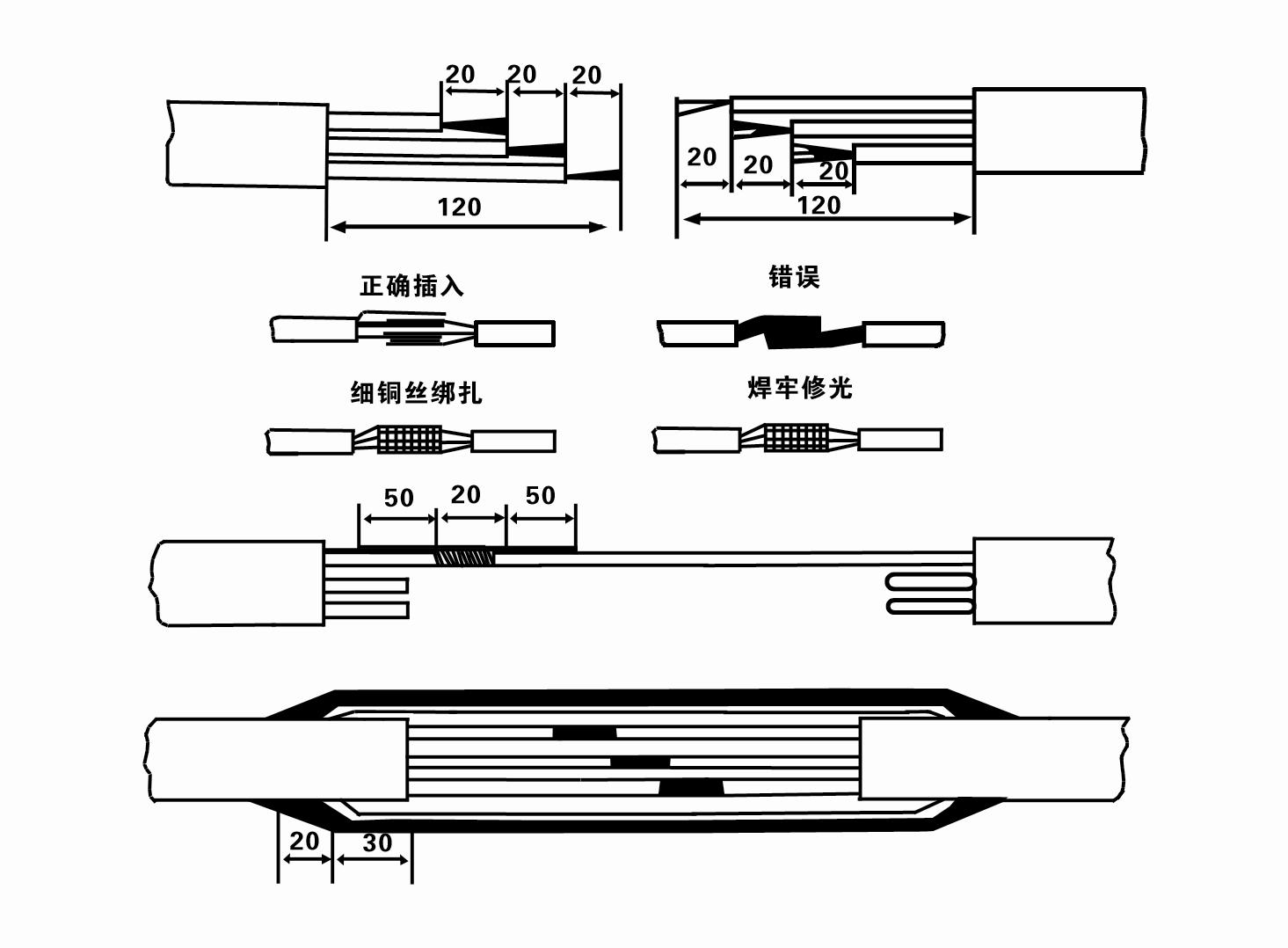
8. Prüfen Sie mit einem Multimeter, ob die Drehstromleitungen angeschlossen sind und der Gleichstromwiderstand etwa ausgeglichen ist.
9. Überprüfen Sie, ob der Stromkreis und die Transformatorkapazität überlastet sind, und schließen Sie dann den Überlastschutzschalter oder die Startvorrichtung an. Siehe Tabelle 2 für bestimmte Modelle. Gießen Sie dann einen Eimer Wasser aus dem Wasserpumpenauslass in die Wasserpumpe, um die Gummilager in der Pumpe zu schmieren, und stellen Sie die Tauchpumpe dann aufrecht und stabil auf. Starten Sie (nicht länger als eine Sekunde) und prüfen Sie, ob die Lenkrichtung mit dem Lenkzeichen übereinstimmt. Wenn nicht, tauschen Sie zwei beliebige Anschlüsse des Dreiphasenkabels aus. Installieren Sie dann den Filter und bereiten Sie sich darauf vor, in den Brunnen zu gehen. Bei Verwendung in besonderen Fällen (z. B. Gräben, Flüssen, Teichen, Teichen usw.) muss die Elektropumpe zuverlässig geerdet sein.
(2)Installationsausrüstung und Werkzeuge:
1. Ein Paar Hebeketten für mehr als zwei Tonnen.
2. Ein Stativ mit einer vertikalen Höhe von mindestens vier Metern.
3. Zwei Hängeseile (Drahtseile), die ein Gewicht von mehr als einer Tonne tragen können (können das Gewicht eines kompletten Wasserpumpensatzes tragen).
4. Installieren Sie zwei Paar Klammern (Schienen).
5. Schraubenschlüssel, Hämmer, Schraubendreher, elektrische Werkzeuge und Instrumente usw.
(3)Installation der elektrischen Pumpe:
1. Das Installationsdiagramm der Tauchelektropumpe ist in Abbildung 2 dargestellt. Die spezifischen Installationsabmessungen sind in Tabelle 3 „Liste der Installationsabmessungen der Tauchelektropumpe“ aufgeführt.
2. Tauchpumpen mit einer Förderhöhe von weniger als 30 Metern können mit Schläuchen und Drahtseilen oder anderen Hanfseilen, die das gesamte Gewicht der gesamten Maschine, der Wasserleitungen und des Wassers in den Rohren tragen können, direkt in den Brunnen gehoben werden.
3. Pumpen mit einer Förderhöhe von mehr als 30 Metern verwenden Stahlrohre und die Installationsreihenfolge ist wie folgt:
①Befestigen Sie das obere Ende des Wasserpumpenteils mit einer Klemme (Motor und Wasserpumpe sind zu diesem Zeitpunkt bereits verbunden), heben Sie es mit einer Hängekette an und binden Sie es langsam in den Brunnen, bis die Klemme auf den Brunnenkopf aufgesetzt und die Hängekette entfernt ist.
② Verwenden Sie ein weiteres Paar Klemmen, um ein Rohr festzuklemmen, heben Sie es mit einer Hängekette 15 cm vom Flansch entfernt an und senken Sie es langsam ab. Legen Sie zwischen Rohrflansch und Pumpenflansch das Gummipolster an und ziehen Sie Rohr und Pumpe mit Schrauben, Muttern und Federscheiben gleichmäßig fest.
③ Heben Sie die Tauchpumpe leicht an, entfernen Sie die Klemme am oberen Ende der Wasserpumpe, binden Sie das Kabel mit einem Kunststoffband fest an die Wasserleitung und binden Sie es langsam nach unten, bis die Klemme am Bohrlochkopf platziert ist.
④Verwenden Sie die gleiche Methode, um alle Wasserleitungen an den Brunnen anzuschließen.
⑤Nachdem das Ausgangskabel mit dem Steuerschalter verbunden ist, wird es an die dreiphasige Stromversorgung angeschlossen.
(4)Bei der Installation zu beachtende Punkte:
1. Wenn während des Pumpvorgangs ein Blockierungsphänomen festgestellt wird, drehen oder ziehen Sie am Wasserrohr, um die Blockierungsstelle zu beheben. Wenn verschiedene Maßnahmen immer noch nicht funktionieren, drücken Sie die Pumpe bitte nicht mit Gewalt nach unten, um Schäden an der Tauchpumpe und dem Brunnen zu vermeiden.
2. Während der Installation sollte am Flansch jedes Rohrs eine Gummiunterlage platziert und gleichmäßig festgezogen werden.
3. Wenn die Wasserpumpe in den Brunnen abgesenkt wird, sollte sie in der Mitte des Brunnenrohrs platziert werden, um zu verhindern, dass die Pumpe längere Zeit gegen die Brunnenwand läuft, was zu Vibrationen der Pumpe und zum Fegen und Verbrennen des Motors führen kann.
4. Bestimmen Sie die Tiefe der Wasserpumpe bis zum Boden des Brunnens entsprechend den fließenden Sand- und Schlickbedingungen des Brunnens. Vergraben Sie die Pumpe nicht im Schlamm. Der Abstand von der Wasserpumpe bis zum Boden des Brunnens beträgt im Allgemeinen nicht weniger als 3 Meter (siehe Abbildung 2).
5. Die Wassereintrittstiefe der Wasserpumpe sollte vom dynamischen Wasserstand bis zum Wassereinlassknoten nicht weniger als 1–1,5 Meter betragen (siehe Abbildung 2). Andernfalls können die Lager der Wasserpumpe leicht beschädigt werden.
6. Die Förderhöhe der Wasserpumpe darf nicht zu niedrig sein. Andernfalls muss an der Wasserleitung am Bohrlochkopf ein Absperrschieber installiert werden, um den Pumpendurchfluss am Nenndurchflusspunkt zu steuern und zu verhindern, dass der Motor aufgrund großer Durchflussraten überlastet wird und durchbrennt.
7. Wenn die Wasserpumpe läuft, sollte die Wasserabgabe kontinuierlich und gleichmäßig erfolgen, der Strom sollte stabil sein (unter Nennbetriebsbedingungen im Allgemeinen nicht mehr als 10 % des Nennstroms) und es sollten keine Vibrationen oder Geräusche auftreten. Bei Anomalien sollte die Maschine angehalten werden, um die Ursache herauszufinden und zu beseitigen.
8. Achten Sie bei der Installation auf die Einstellung des Motorerdungskabels (siehe Abbildung 2). Wenn es sich bei der Wasserleitung um ein Stahlrohr handelt, führen Sie es von der Bohrlochkopfklemme aus; wenn es sich bei der Wasserleitung um ein Kunststoffrohr handelt, führen Sie es von der Erdungsmarkierung der Elektropumpe aus.
1.submersible pump installation is complete, re-check the insulation resistance and three-phase conduction from the switch, check the instrument and start the equipment connection error, if there is no problem, can start the trial, after the start of the instrument indicating readings whether more than the nameplate stipulated rated voltage and current, observe the pump noise and vibration phenomenon, everything is normal can be put into operation.
2.pump operation for the first four hours, should be shut down quickly test the thermal insulation resistance of the motor, the value should not be less than 0.5 megaohm.
3.pump shutdown, should be started after an interval of five minutes, to prevent the water column in the pipe has not completely reflux caused by excessive motor current and burnout.
4.pump into normal operation, in order to prolong its service life, to check the supply voltage, working current and insulation resistance is normal, if found the following situation, should immediately shut down troubleshooting.
1.in the rated condition, the current is more than20%.
2.dynamic water level to the water inlet section, causing intermittent water.
3.submersible pump severe vibration or noise.
4.supply voltage is lower than 340 volts.
5.fuse burned out a phase.
6.water pipe damage.
7.motor to the thermal insulation resistance is less than 0.5 megaohm. 5. The product is a pump unit with easy disassembly function, with simple steps of disassembly, so that users can easily maintain and clean. The disassembly steps include unraveling the cable rope, taking down the pipeline part and the line protection plate, unloosening the water discharge bolt, excluding all the water in the motor chamber, removing the filter and loosening the coupling fixing screw fixing the motor shaft, unscrewing the bolt connecting the water inlet section and the motor, separating the pump and the motor (note that the unit should be leveled when separating to prevent the bending of the pump shaft), the disassembly sequence of the pump is: water inlet section, impeller, shunt shell, impeller, and cleaning the valve body. When disassembling the impeller, use special tools to loosen the conical sleeve fixing the impeller. In the whole disassembly process, avoid bending the pump shaft and damaging various parts. The disassembly process of the motor is: put the motor on the platform, and remove the nuts, base, shaft head lock nut, thrust plate, key, and lower guide rail from the bottom of the motor in order. Bearing seat, tie rod bolt, and then take out the rotor (be careful not to damage the wiring harness) and finally remove the connecting section and the upper guide bearing seat. Before assembling the unit, the rust and dirt of each part should be cleaned, and the sealant should be coated on each mating surface and fastener, and then the assembly should be carried out in reverse order according to the disassembly (the movement of the motor shaft after assembly is about 1 mm). After the assembly is completed, the coupling should be flexibly rotated, and then the filter should be put on for machine test. This pump unit is not only convenient and easy to use, but also has detailed instructions, which provides users with convenient maintenance experience. 6. Submersible electric pump every operation for one year, or less than one year but the diving time has reached two years, should be put out of the well according to Article 5 for disassembly and maintenance, and replace the worn parts.
1. Lassen Sie das Wasser im Motorraum ab (besonders im Winter, um ein Einfrieren des Motors zu verhindern) und binden Sie das Kabel gut fest.
2, store in an indoor room without corrosive substances and gases, with a temperature below 40 °C.
3. Bei längerem Gebrauch sollte auf den Rostschutz der Tauchpumpen geachtet werden.
- Laufrad
- Wellenschutzhülse
- Wellenschutzhülse aus Gummi
-
Siegelring
01 Wasserentnahme aus einem tiefen Brunnen
02 Hochwasserversorgung
03 Bergwasserversorgung
04 Turm Wasser
05 Landwirtschaftliche Bewässerung
06 Gartenbewässerung
07 Flusswasserentnahme
08 Brauchwasser

